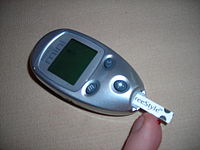
Photo from wikipedia
"Relative hypoglycemia" is an often-overlooked complication of diabetes characterized by an increase in the glycemic threshold for detecting and responding to hypoglycemia. The clinical relevance of this problem is linked… Click to show full abstract
"Relative hypoglycemia" is an often-overlooked complication of diabetes characterized by an increase in the glycemic threshold for detecting and responding to hypoglycemia. The clinical relevance of this problem is linked to growing evidence that among patients with critical illness, higher blood glucose in the intensive care unit is associated with higher mortality among patients without diabetes but lower mortality in patients with preexisting diabetes and an elevated prehospitalization HbA1c. Although additional studies are needed, the cardiovascular stress associated with hypoglycemia perception, which can occur at normal or even elevated glucose levels in patients with diabetes, offers a plausible explanation for this difference in outcomes. Little is known, however, regarding how hypoglycemia is normally detected by the brain, much less how relative hypoglycemia develops in patients with diabetes. In this article, we explore the role in hypoglycemia detection played by glucose-responsive sensory neurons supplying peripheral vascular beds and/or circumventricular organs. These observations support a model wherein relative hypoglycemia results from diabetes-associated impairment of this neuronal glucose-sensing process. By raising the glycemic threshold for hypoglycemia perception, this impairment may contribute to the increased mortality risk associated with standard glycemic management of critically ill patients with diabetes.
Journal Title: Diabetes care
Year Published: 2023
Link to full text (if available)
Share on Social Media: Sign Up to like & get
recommendations!